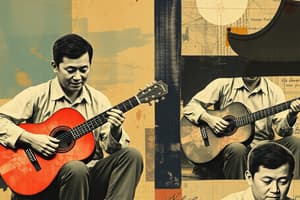Podcast
Questions and Answers
What does folk arts refer to?
What does folk arts refer to?
Arts that are traditional and have been around for many years, including folk music, folk dances, traditional festivals, theater arts, and visual arts.
What is 'Pakiusap'?
What is 'Pakiusap'?
A film produced in the Philippines before World War II, notable as one of the few surviving pre-war Filipino movies.
Which of the following is a type of sacred music?
Which of the following is a type of sacred music?
- Secular Music
- Liturgical Music (correct)
- Instrumental Music
- Folk Music
What is liturgical music?
What is liturgical music?
What is devotional music?
What is devotional music?
What is 'Pabasa ng Pasyon'?
What is 'Pabasa ng Pasyon'?
What are the characteristics of folk songs?
What are the characteristics of folk songs?
What is 'Kumintang'?
What is 'Kumintang'?
The _____ is a type of courtship song sung by a male in front of a woman's window.
The _____ is a type of courtship song sung by a male in front of a woman's window.
What does 'Balitaw' express?
What does 'Balitaw' express?
Flashcards are hidden until you start studying
Study Notes
Folk Arts
- Folk arts are traditional practices passed down through generations, often via oral traditions.
- These arts encompass various forms, including music, dance, festivals, theater, and visual arts.
Folk Music of Southeast Asia
- Traditional music reflects rich cultural heritages unique to each Southeast Asian nation.
Traditional Music in the Philippines
- "Pakiusap," produced before WWII, is one of the few surviving pre-war Filipino movies showcasing Filipino Kundiman.
- Sacred music in the Philippines serves religious purposes, often linked to organized worship.
Types of Sacred Music
- Liturgical Music: Used during holy masses and liturgies like vespers, based on the prayer texts of the Mass.
- Key elements include Kyrie, Glorias, Credo, Sanctus, and Agnus Dei.
- Devotional Music: Focuses on expressing respect and devotion to God outside formal liturgical settings.
Religious Gatherings
- Masses are significant religious events featuring vocal music, rooted in traditional Latin rites introduced by Spaniards in the 16th century.
Traditional Folk Performances
- Pastores (Estudiantinas): A group of performers (usually 12) dressed in colorful costumes, singing Christmas carols for alms.
- Moro-Moro/Komedya: Plays depicting conflicts between Christians and Moros, often performed with humor.
- Pabasa ng Pasyon: A 12-hour communal singing of the life of Christ during Lent, known locally as "Panata."
- Salubong: A dramatic procession of Mater Dolorosa and Risen Christ, accompanied by singing.
- Senakulo: Lenten plays depicting events related to Jesus' life, suffering, and death.
Vocal Music Categories
- Secular Music: Non-religious songs primarily for entertainment, work songs, or celebrations.
Characteristics of Folk Songs
- Melodies are memorable and syllabically set in stanzas.
- Often structured in strophic form with one melody per stanza.
- Typically utilize major and minor scales and can feature triple and duple meters, often accompanied by guitar.
Notable Forms of Folk Songs
- Magtanim Ay Di Biro: A traditional folk song.
- Harana: A local serenade where a male expresses affection through song at a female's window, consisting of four stages: Panawagan, Pagtatapat, Panagutan, and Pamaalam.
- Balitaw: A 3/4 time signature song expressing love, which may also include dance and features a rhythmic bass.
- Kumintang: A war song and dance highlighting love and courtship, performed by exchanging musical phrases while passing around lambanog, a local coconut wine.
Studying That Suits You
Use AI to generate personalized quizzes and flashcards to suit your learning preferences.




